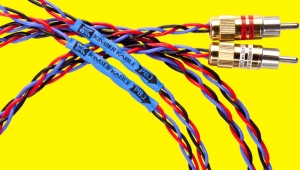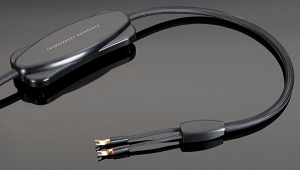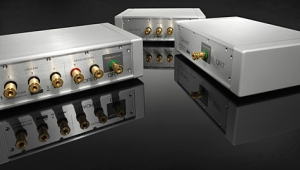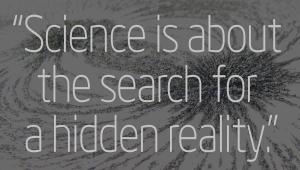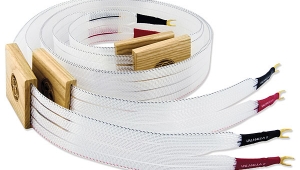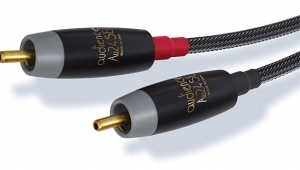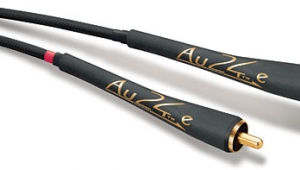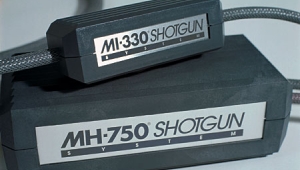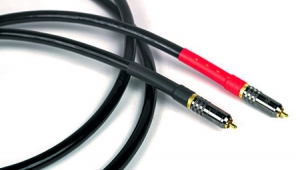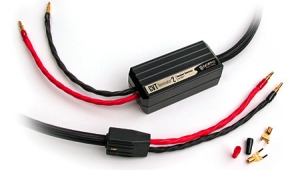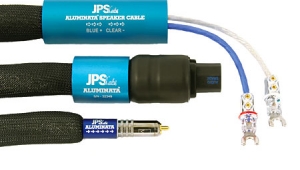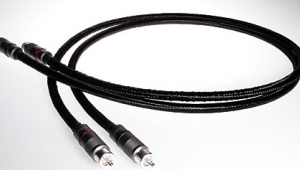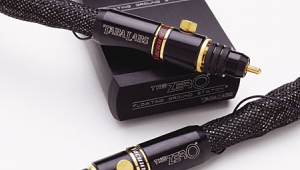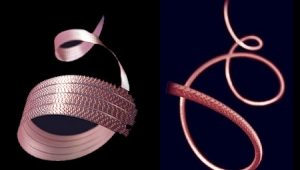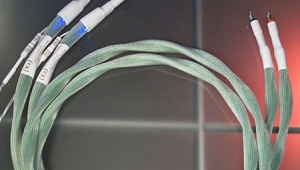| Columns Retired Columns & Blogs |
Synergistic Research cables Chip Stern
Chip Stern wrote about Synergistic Research in November 2001 (Vol.24 No.11):
Having spent much time in the past five years experimenting with the sound signatures and interactions of speaker cables, interconnects, and power cords from JPS Labs, AudioQuest, Straight Wire, Cardas, Monster Cable, Acoustic Zen, and Synergistic Research, I continue to regard cables not as aural afterthoughts but as essential components. From the humblest rigs to the most expensive systems, I've seen how careful fine-tuning with cables can help maximize the music-reproduction potential of each associated component. During this same time I've often observed Stereophile equipment-reports editor Jonathan Scull doggedly experimenting with endless combinations of cables, seeking to optimize those critical junctures—source component to preamp, preamp to power amp, power amp to speakers—so that he might hear the component under review at its best, and thus judge its optimal effect on his reference system.
In the last few years I've found myself returning again and again to Synergistic Research cables, interconnects, and power cords as my references. I've grown to depend on their high resolution, clarity, and midrange detail to reveal the sonic wings and warts of gear at all points in the signal chain, particularly with the shielding technology that they have developed.
Active Shielding
According to SR honcho Ted Denney III, Synergistic Research's original "Discrete Shielding" "improves the efficiency of our interconnects by buffering the shield from ground. With a normally shielded interconnect, any noise that is picked up by the shield of a cable is passed directly to the ground circuit of the components they are connecting. With Discrete Shielding, any noise that is picked up on the shield of our interconnects is buffered before it can enter the ground circuit of the components they are connected to."
SR claims the net result of Discrete Shielding is a 6dB drop in the noise floor of their interconnects. When I replaced my original set of Resolution Reference Phase II interconnects with an updated version, I wrote in the April 1999 Stereophile (p.185): "There's a lot more air and harmonic detail, with greater bass extension, and deeper, more open soundstaging; there is also significantly more high-frequency information, yet the overall frequency response is a lot smoother, less brassy and forward. It made the old interconnects, themselves no slouches, sound rather veiled by comparison."
But Synergistic Research's most dramatic aural refinement was a process they call "Active Shielding." This applies a DC voltage bias to the shielding via little pigtails ending in 1/8" minijacks that are located just behind the RCA connectors. A separate Master Control Center has one or two power-supply and filtering modules, each capable of powering three pairs of cables. (All current Phase Two and higher SR interconnects are supplied ready for Active Shielding; Phase One interconnects with Discrete Shielding can be modified by SR dealers; pre-Discrete Shielding interconnects, from Alpha through Designers' Reference can be modified at the factory—call (800) 576-6489 for details and an RA number.)
"Active Shielding works outside the signal path," Denny explains, "to prevent RFI and EMI distortion from penetrating the shield of the cable and corrupting the signal. In addition to lowering the noise floor of our cables by as much as 12dB or more, depending on the cable geometry, the Master Control Center reduces the amount of energy that leaches into the dielectric from musical signals traveling down the conductors by saturating the dielectric with its own energy, which creates a field that holds the music signal in its own conductors."
After I auditioned my first Active Shielded cables, I wrote in a first blush of excitement, for "Recommended Components" in April 2000: "If Discrete Shielding represented a significant improvement in the performance of [Synergistic's] old Resolution Reference Mk.II interconnects, then the upgrade to Active Shielding is profound. Imagine your soundstage illuminated from within, as if you were used to filtering white light through a prism and getting the three primary shades, whereas now you've got dozens of different hues and colors no one knows the names of." I was also conscious of a wealth of spatial cues—stupefying dimensions of soundstage layering. The heightened sense of dimensionality was intoxicating—whenever I disengaged Active Shielding, I was keenly conscious of its absence.
Still, the original implementation of Active Shielding was a little dicey; I soon discovered any number of novel ways to short out internal fuses. The rear-panel connection points on the Master Control Center for those 1/8" minijacks was cheesy; I couldn't get a really firm connection, and if I moved stuff around in the back of my rack, there was always a chance of jiggling an interface cable loose—or, if I got metal-on-metal contact, there'd be a spark, like a little static discharge. In this manner I blew out a fuse or two.
Likewise, the many extensive A/B comparisons that are part of my routine necessitated removing the power cord, either from its IEC inlet on the back of the unit or from the wall socket—inexplicably, there was no On/Off or Standby switch on the Control Center. And when I left my system on overnight, the illuminated sapphire glow of the tiny LED on the front panel sometimes went out while I slept.
Some months later I received from Synergistic Research an upgraded Master Control Center, which addressed my primary concerns. The interface cables employed a better quality of stranding; more significant, the flimsy 1/8" minijack connections on the back of the Master Control Center were replaced by a more solid, stable array of locking BNC connections. In addition, the 1/8" minijack sockets on the interconnect pigtails were now contained in plastic sleeves to prevent metal-to-metal contact. Still, I continued my practice of powering down the Active Control Center anytime I was changing cables, power cords, or interconnects. With the addition of an On/Off mini toggle switch on the chassis' left front panel adjacent to that faint sapphire LED, this was now a simple matter.
You can buy a Master Control Center with one module plus a Resolution Reference Master Coupler for $1300, or $2400 with Synergistic Research's top-of-the-line Designers' Reference Master Coupler. (Add $250 for an additional module.)
Further listening
For my final round of auditions I used SR's Designers' Reference and Resolution Reference Mk.II interconnects, with Designers' Reference Master Coupler power cords on my preamp, power supplies, source components, and the Master Control Center itself (though I used JPS Labs' new Aluminata power cord on my power amp). My tube/solid-state Musical Fidelity Nu-Vista 300 power amplifier was driven by a Blue Circle BCG3 Galatea triode preamp. Rounding out the system were: a Sony SCD-777ES SACD player and the California Audio Labs CL-20 20-bit/96kHz DVD-V/HDCD player; a Rega Planar 3 turntable with Grado Reference Master cartridge and Musical Fidelity X-LP2 dual-mono phono preamp; the Marantz PMD 430 professional cassette recorder; a pair of Meadowlark Hot Rod Shearwaters (a two-way, floorstanding loudspeaker biwired with SR Resolution Reference Mk.II for the bass and SR Designers' Reference for the treble).
Although the Control Center now has an On/Off toggle switch, it still takes a little while for the shielding both to become saturated when the Active Shielding is turned on and to dissipate when it's turned off. At first, the Active Shielding effect seemed fairly subtle, growing more palpable as it came on and as I learned to listen for its sonic signatures: more natural timbres and enhanced bass energy, which translated into extended dynamics and deeper, more holographic soundstaging; greater front-to-back imaging and focus especially on vocals; each instrumental image seeming to be individually backlit, with a greater sense of layering, localization, and inner detail; and greater retrieval of ambient information and microdynamics. This gave a more pronounced sense of air and space, with blacker backgrounds and less sense of the music originating from a point source.
Curiously enough, like so many strategic tweaks, Active Shielding's effects seemed more apparent in their absence. When I powered down my interconnects, the soundstage seemed to contract and become more shallow. On a more subtle level, Active Shielding's spooky sense of luminescence—an inner glow accorded individual images—receded as well.
The best interconnects I've ever heard? Hard to say, given the subtle nature of system interactions, room anomalies, and aural preferences that seem to prefer certain combinations of cables over others. But even without Active Shielding, Synergistic Research Designers' Reference cables are more than competitive with the cream of contemporary high-end cables—and adding Active Shielding seemed both to illuminate and deepen the soundstage and generally firm things up.
Real-world stuff
Two more recent and cost-effective applications of the Active Shielding technology (first introduced in May, at Home Entertainment 2001) offer entry-level consumers even more dramatic performance enhancements. The new Synergistic Research Mini-Power Coupler resembles a wall wart equipped with a pair of interface cables each terminating in a 1/8" minijack for Active Shielding–ready SR interconnects. (The price is $250 for a 1m pair of Alpha Sterling interconnects with Mini-Power Coupler. SR also offers a free MPC with the purchase of any pair of Phase II or higher interconnects.)
More significantly, SR has now applied their Active Shielding technology to speaker cables—a 10' single or biwire run of their Alpha is $350 with MPC. I tried this combo on my secondary reference system in my wife's piano studio with a pair of Joseph RM7si Signature minimonitors and a Musical Fidelity A3 integrated amp and A3 CD player. To be on the safe side, much as SR was for their HE2001 A/B demos, I plugged each MPC into an inexpensive RadioShack power strip with an On/Off switch, plugged that into a JPS Labs Power AC Outlet Center, and that into the wall socket.
The MPC doesn't offer the filtration circuitry of the Master Control Center's internal modules, and it didn't convey quite the level of dynamics, refinement, and coherence of its big brother. Still, for a modest investment of $600, Active Shielding transformed the sonic signature of these inexpensive cables in startling manner. Comparing the performance of the $250 Alpha Sterling/MPC combo with the exceptionally musical Straight Wire Serenade interconnects ($380/1m pair), I heard greater transient snap, speed, and focus in the bass response; more air and spatial cues; and that subtle sense of layering and illumination I so enjoyed in the higher-priced spread.
However, the most impressive thing about the MPC was the way it seemed to extend the soundstaging right through the rear wall, conveying greater depth and dimensionality than I was used to hearing. (Practical considerations have forced me to position my speakers much closer to the rear wall than is ideal.) Adding a set of SR's active Alpha speaker cables (with their cute little blue LEDs) to the signal chain further enhanced the holographic effect, and resulted in a more involving sense of layering and liquidity.
Synergistic Research might just be competing against itself. I found the contribution of the way cool, inexpensive little Mini-Power Couplers to be more pronounced and profound in my cost-effective secondary reference system than in my main setup. That makes sense when you factor in the refined aural qualities one might reasonably hope to hear from the more sophisticated geometry and pricey materials of any top-of-the-line interconnect. Compared to cables costing two to three times as much, the Active Shielding–equipped Sterling/Alpha combo offered significantly more vivid, lifelike performance.Chip Stern
- Log in or register to post comments
